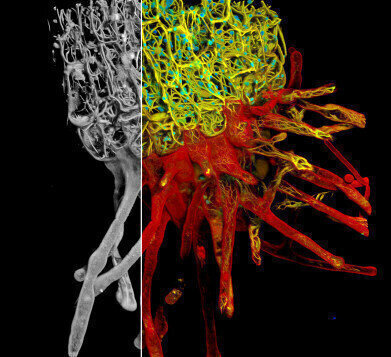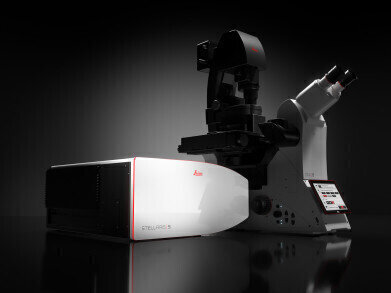-
 Simultaneous spectral (grey) and TauSense mode TauContrast (colour) confocal imaging reveals contrast by lifetime. Root-hypocotyl-junction of Arabidopsis thaliana (Era et al. Plant Cell Physiol., 2009). Chlorophyll, Life-Act Venus, IProp.Sample courtesy: Dr Krebs, COS, University of Heidelberg.
Simultaneous spectral (grey) and TauSense mode TauContrast (colour) confocal imaging reveals contrast by lifetime. Root-hypocotyl-junction of Arabidopsis thaliana (Era et al. Plant Cell Physiol., 2009). Chlorophyll, Life-Act Venus, IProp.Sample courtesy: Dr Krebs, COS, University of Heidelberg. -
 The STELLARIS 5 system is part of the new confocal microscopy platform STELLARIS from Leica Microsystems.
The STELLARIS 5 system is part of the new confocal microscopy platform STELLARIS from Leica Microsystems.
Microscopy & Microtechniques
New Platform Provides a New Dimension of Information to Confocal Imaging
Jul 20 2020
Leica Microsystems has announced the launch of its flagship new confocal microscopy platform, called STELLARIS. The platform will significantly improve how scientists are able to capture three-dimensional images of living cells and tissues.
STELLARIS gives access to lifetime-based information in every experiment, in parallel with common intensity imaging approaches. Scientists will find that the unique TauSense lifetime-based imaging modes open up the potential to discover more. These modes complement a multitude of new ways to explore the function of molecules in their cellular context and help, for example, separate fluorophores even when their emissions fully overlap. Another benefit is that the number of simultaneous detection channels can be expanded by using lifetime-based information. Access to this advanced imaging information takes just one click. The new smart user interface, ImageCompass, ensures that scientists have the productivity to do more, as setting up even complex experiments is now much easier and more intuitive than ever before.
STELLARIS offers significant enhancements compared to existing confocal systems on the market. The enhanced sensitivity in the blue-green range (PDE > 55%) improves the detection limits and dynamic range for the most commonly used fluorophores. The extension of the detection range to the Near Infrared (NIR) provides up to 67% more dynamic range compared to current state-of-the-art detectors. The NIR extension allows for additional freedom when selecting dyes and up to three additional colours. The new detector generation in combination with the renowned Leica spectral detection technology and a newly designed beam path to maximise transmission efficiency, enables efficient signal acquisition while valuable samples are afforded the lowest possible exposure to light. Ultimately, this facilitates ‘gentle’ live cell imaging, preserving sample integrity and improving reproducibility of results.
The integrated TauSense is an innovative set of imaging modes based on fluorescence lifetime without the need to add extra dedicated hardware. It enables scientists to differentiate between specific fluorescence signals and unwanted autofluorescence to improve the quality of the final image and separate fluorophores that could not be previously separated with spectral unmixing.
More informationonline
Events
Aug 22 2022Frankfurt, Germany
Aug 27 2022Maastricht, Netherlands
Aug 28 2022Lisbon, Portugal
Aug 31 2022Singapore
Sep 06 2022Shanghai, China





.jpg)














